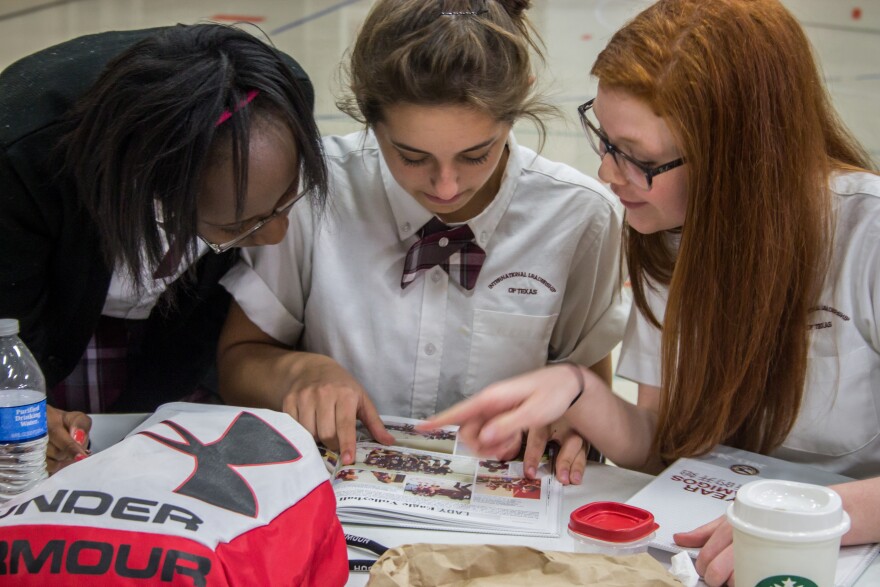These days, kids are most likely to text each other or communicate with apps like Snapchat. They post photos on Instagram and they tweet what they’re doing throughout the day. As part of KERA’s American Graduate initiative, we talk to some students about how even in this fast-paced digital world, the printed yearbook is still an end-of-the-year highlight for some students.
It’s lunchtime at International Leadership of Texas High School in Garland. Kids stream inside the noisy gymnasium as Top 40 music plays on a radio. They approach a table where art and yearbook teacher Claire Sneau stands marking off names on a list.
“Can I get my yearbook, Ms. Sneau?” a student asks as he approaches the table.
“Yes,” she says.
“Look at Justin,” another kid says, laughing as she points to her friend’s photo in the yearbook.
For some of the 155 students at the school, this is the first time they’ve ever seen a yearbook. It may not be digital, but as Sneau explains, it’s not entirely different from what kids are used to seeing online these days.
“Because it’s kind of like the parts that they like of FB and Instagram because it is so photography heavy,” Sneau says. “So they liked the images and seeing their friends and going through the photos. Just like they do on FB and Instagram.”

Sneau said teaching students how to produce a yearbook was fun, but also challenging. To manage the project, she set up a Google calendar that she and her students used to schedule assignments and coverage of upcoming school activities.
“There was a big learning curve because none of them have ever participated in it before,” Sneau said. “So there was a lot of thought that it was just photography and so it was interesting to see as they continued to work on it and it evolved, how they found their niches.”
By the end of the year, some students had excelled in photography and others in writing and interviewing skills. And although the final product is a hardcover book, the production of it — designing pages, writing headlines and other text and uploading photos — was done entirely online.
Ninth-grader Alex Gutierrez, who we’ve been following in our Class of ’17 series said she realized there’s more to a yearbook than she originally thought. And, she said, it was harder to work on than she imagined.
“It’s like a puzzle,” Gutierrez said. “You grab all the pieces and you put it together and you never know what it’s gonna look like.”
Today, 93 percent of teens between 12 and 19 are online according to the Pew Research Center. So what do teens see in an old-school tradition like the yearbook? Teon Carr, 15, sums it up like this:
“I think students will always appreciate yearbooks because like it creates memories in school and the online media is like outside of school and these are more important,” Carr said.

Nearby, a couple of girls sit at a table commenting on various pages. One of the girls can’t contain her laughter when she notices her sibling.
“My brother!” she yells out.
At International Leadership of Texas, which opened this school year, the students learn English, Spanish and Chinese, so they had the cover printed in all three languages. The title? “New Year, New Friends, New Beginnings.”
Besides class photos and snaps of kids participating in activities, the book includes the results of student surveys asking “Who would rather?” In one polls, 70 percent of kids would rather read minds versus know the future, while 64 percent of students prefer YouTube over Vine. And are Vans or Converse shoes more popular? Fifty-seven percent say Vans.
Tenth-grader Hannah Carman – one of 90 students who bought a yearbook – said she couldn’t wait to look through it.
“Honestly, I’m really excited,” Carman said. “Mostly because in a few years, I can like look back and see all the people who I became close friends with on the first year.”
Hannah darts off and heads toward a table with friends. Some are engrossed in their book reading and flipping through it, others scribbling messages on the pages.








